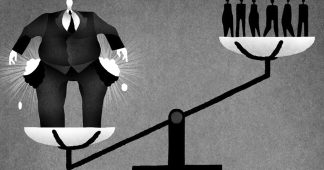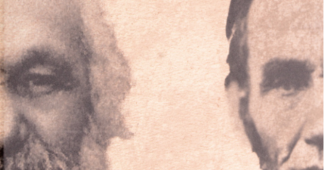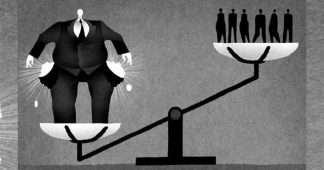By Eric London
9 November 2019
The following lecture was delivered on Tuesday, November 5 at the University of Michigan in Ann Arbor. It was the second in a series of three lectures at the U of M in response to the New York Times’ “1619 Project,” which presents a falsified, racialist interpretation of American history. Lectures on this topic are being held across the country under the title “Race, Class and the Fight for Socialism: Perspectives for the Coming Revolution in America.” The first lecture, titled “Slavery and the American Revolution: A Response to the New York Times’ 1619 Project,” was held November 1.
The purpose of this lecture series, hosted by the Socialist Equality Party, is to address the falsifications of the New York Times’ “1619 Project” and undertake a historical materialist analysis of American history, and in this lecture, the Civil War. Our purpose is not academic. Our aim to elaborate the strategy for socialist revolution.
The “1619 Project” is a politically motivated attack on historical truth. Through this initiative, the Democratic Party seeks to present race, and not class, as the essential dividing line in American and world society.
This historical falsification has a clear political value for the American financial aristocracy. In the US, the wealthiest 1 percent of households now owns 40 percent of the wealth. The next 9 percent owns another 30 percent, meaning the top 10 percent owns 70 percent of all wealth. The bottom 50 percent—160 million people—owns less than 2 percent. That’s less than the 3 percent owned by the richest 400 Americans.
Only an oligarchic society such as this one could produce a figure like Trump, who epitomizes in his reactionary politics and personal depravity all the characteristics of the degenerate financial aristocracy.
In a country of 320 million people, roughly 285 million—the bottom 90 percent—constitute the working class. Of those, roughly 40 million are identified as black, 170 million are identified as white, 50 million are Hispanic, 17 million are Asian, and 4 million are Native American. Of all categories, roughly 40 million are foreign born, while another 35 million are second-generation immigrants. And, of course, within each category there are younger and older workers and women and men. Within this diverse working class, there exist various levels of stratification—from highly skilled workers with higher incomes to those living below or at the very fringes of solvency.
These are just the figures for the working class in America. Across the world the working class comes from all different national and cultural backgrounds. The workers’ position in society, however, is determined not by the color of their skin, their religion, their language or their gender, but by their class—by the fact that they sell their labor power in order to survive. The task of socialists is to break down the racial myths, clarify the historical record and bring workers of all the backgrounds together in a common, united struggle for social equality.
Historical falsification and identity politics are strategic weapons in the hands of the ruling class, which deliberately employs these tools to weaken the objective position of the working class by pitting workers against each other and thereby suppressing the class struggle. Trump opts for the openly fascistic method, scape-goating immigrants, excoriating socialism and appealing to the most openly racist elements of American society.
But this lecture will address the Democratic Party and its history, its use of racial politics—today and in the decades leading up to the Civil War. Today, this brand of racialism is in no way a progressive alternative to the fascism of Trump. In fact, as an ideology, the Democratic Party’s identity politics shares much in common with the party’s racist roots and with fascist racial and irrationalist theories of the early 20th century. It is an extremely dangerous and right-wing ideology and it must be opposed.
This critique will focus on two articles in the 1619 Project, the first by journalist and Times staff writer Nikole Hannah-Jones, the originator of the project, titled “Our democracy’s founding ideals were false when they were written. Black Americans have fought to make them true,” and the second, by Princeton sociologist Matthew Desmond, titled “In order to understand the brutality of American capitalism, you have to start on the plantation.”
Both Hannah-Jones and Desmond argue that slavery was the fault of all white people, who are fundamentally predisposed to be racist. Key to the argument of Hannah-Jones is the claim that even Abraham Lincoln’s Emancipation Proclamation had no relation to any progressive political struggle for equality. In her words, Lincoln “blamed them [black people] for the [civil] war.” The decision to free the slaves was merely a question of winning the war. She writes, “Anti-black racism runs in the very DNA of this country, as does the belief, so well articulated by Lincoln, that black people are the obstacle to national unity.” We will return to Mr. Lincoln momentarily.
The Times asserts that the entire white population, poor and rich alike, supported and benefited from slavery and violently opposed post-war Reconstruction. Desmond claims, “Witnessing the horrors of slavery drilled into poor white workers that things could be worse. So they generally accepted their lot, and American freedom became broadly defined as the opposite of bondage. It was a freedom that understood what it was against but not what it was for; a malnourished and mean kind of freedom that kept you out of chains but did not provide bread or shelter. It was a freedom far too easily pleased.”
Referencing the period following the Civil War, Hannah-Jones similarly states, “The many gains of Reconstruction were met with fierce white resistance throughout the South, including unthinkable violence against the formerly enslaved, wide-scale voter suppression, electoral fraud and even, in some extreme cases, the overthrow of democratically elected biracial governments.”
And further: “White Southerners of all economic classes, on the other hand, thanks in significant part to the progressive policies and laws black people had championed, experienced substantial improvement in their lives even as they forced black people back into a quasi-slavery.”
How convenient for the capitalist class and the multi-millionaire editors of the New York Times that the 1619 authors conclude that the historic levels of inequality and exploitation in America today are not the fault of today’s ruling class, but of… the “DNA” of the country in general, and “white people” of “all economic classes” in particular.
In our reply on the World Socialist Web Site, we juxtaposed to this racialist method the Marxist method of historical materialism. We wrote:
This is a false and dangerous conception. DNA is a chemical molecule that contains the genetic code of living organisms and determines their physical characteristics and development. The transfer of this critical biological term to the study of a country—even if meant only in a metaphorical sense—leads to bad history and reactionary politics. Countries do not have DNA, they have historically formed economic structures, antagonistic classes and complex political relationships. These do not exist apart from a certain level of technological development, nor independently of a more or less developed network of global economic interconnections.
The methodology that underlies the 1619 Project is idealist (i.e., it derives social being from thought, rather than the other way around) and, in the most fundamental sense of the word, irrationalist. All of history is to be explained from the existence of a supra-historical emotional impulse. Slavery is viewed and analyzed not as a specific economically rooted form of the exploitation of labor, but, rather, as the manifestation of white racism. But where does this racism come from? It is embedded, claims Hannah-Jones, in the historical DNA of American “white people.” Thus, it must persist independently of any change in political or economic conditions.
Having introduced the positions of the Times, let’s address the real historical record, starting with the Great Emancipator, Abraham Lincoln.
Lincoln the attorney would have pointed out that since Hannah-Jones and Desmond have impeached his political character by claiming that he “blamed blacks” for the Civil War and have presented the abolition of slavery as a reluctant act of last resort, we are entitled to introduce evidence to rehabilitate him and in so doing address the Times’ underlying falsifications of the whole historical period.
As a preliminary issue, one feels the need to remind these people of the small matter that Lincoln did, in fact, carry out one of the most revolutionary acts of the 19th century—freeing the slaves—a task for which he was assassinated. It was a world dominated by kings and tsars, with Europe mired in reaction following the defeats of the revolutions of 1848. Millions of serfs roamed Eastern Europe. The English crown was pumping China with opium and robbing the country blind. France invaded Mexico and established an emperor to collect its debts. Millions more risked their lives traveling on disease-ridden ships to throw off the weight of feudal reaction and make it in America. Fifteen years after Cavaignac suppressed the Paris workers in blood and eight years before Thiers would do the same to the Commune, Abraham Lincoln sat at his desk and wrote that four million human beings—with a market price of billions of dollars in today’s money—were “Thenceforth and forever free.”
Lincoln is an absolutely unique figure in American history. His own life is insolubly connected to the American Revolution, which Tom Mackaman addressed in the first of this lecture series. Lincoln was born on February 12, 1809, with three weeks remaining in the second term of President Thomas Jefferson, author of the Declaration of Independence.
In his biography of Lincoln, Sidney Blumenthal summarizes Lincoln’s young career in relation to the question of slavery:
Lincoln’s deepening understanding of slavery in its full complexity as a moral, political, and constitutional dilemma began in his childhood among the Primitive Baptist antislavery dissidents in backwoods Kentucky and Indiana, whose churches his parents attended. As a boy he rode down the Mississippi River to New Orleans, where the open-air emporium of slaves on gaudy display shocked him. His development was hardly a straight line, but he was caught up in the currents of the time. His self-education, which started with his immersion in the Bible, Shakespeare, and the freethinking works of Thomas Paine and French philosophes, was the intellectual foundation for his profoundly felt condemnation of Southern Christian pro-slavery theology.
Lincoln’s hatred for slavery was in part personal. Blumenthal explains that at a campaign event, Lincoln, “the man who had been extraordinarily reluctant about discussing his past, sensitive about his social inferiority, blurted out a startling confession:”
“I used to be a slave,” said Lincoln. He did not explain what prompted him to make this incredible statement, why he branded himself as belonging to the most oppressed, stigmatized, and untouchable caste, far worse than being accused of being an abolitionist. Illinois, while a free state, had a draconian Black Code. Why would Lincoln announce that he was a former “slave?” The bare facts he did not disclose to his audience were these: Until he was twenty-one years old, Lincoln’s father had rented him out to neighbors in rural Indiana at a price of ten to thirty-one cents a day, to labor as a rail splitter, farmhand, hog butcher, and ferry operator. The father collected the son’s wages. Lincoln was in effect an indentured servant, a slave. He regarded his semiliterate father as domineering and himself without rights.
Lincoln’s political career was dedicated to opposing the domination of the interests of the Southern slave owners on American political life, a domination they exercised after the conclusion of the so-called “Era of Good Feelings” through the newly formed Democratic Party. From the 1830s, Lincoln was attracted to and active within the Whig Party, led by Henry Clay of Kentucky, a vicious opponent of Andrew Jackson and the Democrats and an advocate of national economic development—a specter the Democratic Party and the slaveholders opposed on the grounds that economic modernization would undercut the backward slave system.
A word about the Democratic Party’s ignoble roots and its long strategy of inflaming racial divisions to maintain social stability and protect private property. The Democratic Party is one of the oldest bourgeois political parties in the world, formally founded in 1828. It was consciously conceived of by Southern slave owners and Northern Tammany politicians as an alliance to protect the interests of the slave owners and preserve social stability in both South and North. The ideological glue of this alliance was an obsessive focus on race and identity, directed first and foremost against blacks, indigenous people and, later, the Chinese.
Two figures stand out in the enunciation of this strategy: John C. Calhoun and Martin Van Buren.
Democrat John C. Calhoun, South Carolina senator and vice president during the presidencies of John Quincy Adams and Andrew Jackson, was an extremely class conscious slave owner, aware that slavery could not politically survive on the basis of sectionalism alone. In 1828, he appealed to wealthy Northerners and said: “After we [the planters] are exhausted, the contest will be between the capitalist and operatives [workers]; for into these two classes it must, ultimately, divide society. The issue of the struggle here must be the same as it has been in Europe.”
The historian Richard Hofstadter labeled Calhoun the “Marx of the Master Class,” writing:
Calhoun proposed that no revolution should be allowed to take place. To forestall it he suggested consistently—over a period of years—what Richard Current has called “planter-capitalist collaboration against the class enemy.” In such a collaboration the South, with its superior social stability, had much to offer as a conservative force. In return, the conservative elements in the North should be willing to hold down abolitionist agitation; and they would do well to realize that an overthrow of slavery in the South would prepare the ground for social revolution in the North.
Calhoun said in the Senate:
There is and always has been in an advanced stage of wealth and civilization a conflict between labor and capital. The condition of society in the South exempts us from the disorders and dangers resulting from this conflict; and which explains why it is that the political condition of the slaveholding states has been so much more stable and quiet than that of the North… The experience of the next generation will fully test how vastly more favorable our condition of society is to that of other sections for free and stable institutions, provided we are not disturbed by the interference of others, or shall… resist promptly and successfully such interference.
Calhoun’s alliance was forged in no small part through the political talent of New York’s Martin Van Buren, known as the “little magician” and “the Red Fox of Kinderhook.” He headed the Democratic ticket after Jackson’s second term, becoming president for one term from 1837 to 41.
Van Buren was a master politician who, well before he became president, understood that growing Northern cities would become centers of class struggle and that the ruling class needed a strategy to maintain social order. The historian Daniel Walker Howe describes Van Buren’s own class conscious political motives for forging the Democratic alliance:
Leaders preoccupied with sovereignty and authority sensed a very real problem in America: the danger of anarchy. Significantly, when Martin Van Buren was in England at the time of the Great Reform Bill of 1832, his comments on it had to do not with improving the quality of representative government but his fears for maintaining order.
Such concerns among Northern elites led Calhoun to comment that those elites feared “the needy and corrupt in their own section. They begin to feel what I have long foreseen, that they have more to fear from their own people than we from our slaves.”
Through the Jackson administration and afterward, fanning racial hatred of the slaves and freed blacks became the Democrats’ ideological mechanism for tying the northern political machines to the political interests of the southern slave owners. In both cases this racial politics had equal utility, maintaining slavery in the south and maintaining profits for the urban northern industrialists. Poor whites and arriving immigrants were informed by the Democrats that it was not their class, but their race that determined their social position. They should fear a race war if the slaves were ever freed. This became the glue that held together the Democratic Party’s cross-regional alliance—solidified by efforts to twist Northern workingmen’s organic hatred of the new capitalist exploitation by idealizing slavery as the lesser evil.
There was another tradition that arose in opposition to the slave owners’ conspiracy to dominate the entire political system, North, South, East and, in particular, West. Trailblazing abolitionists like publisher William Lloyd Garrison characterized the heroic spirit of these radical iconoclasts in his letter “To the Public” in the first edition of the abolitionist The Liberator on January 1, 1831, three decades before the war, published when Lincoln was a young man:
I determined, at every hazard, to lift up the standard of emancipation in the eyes of the nation, within sight of Bunker Hill and in the birth place of liberty. That standard is now unfurled; and long may it float, unhurt by the spoliations of time or the missiles of a desperate foe—yea, till every chain be broken, and every bondman set free! Let southern oppressors tremble—let their secret abettors tremble—let their northern apologists tremble—let all the enemies of the persecuted blacks tremble.
Lincoln, though not an abolitionist, spent his young career opposing the Democratic Party, at first as a leader of the Whigs in Illinois. While Lincoln was active in the Whig Party, first in the state legislature and then as a representative in Congress, the US conquered new territory and forced its way westward—both through robbing Mexico of half its territory in the Mexican-American war and through the extermination and forced removal of Native Americans. The question of slavery was addressed in numerous “compromises” regarding the extension of slavery, orchestrated by the Whigs and by Clay himself. The American population, though not overwhelmingly or explicitly abolitionist in its political sentiments, came to view the expansionist aims of the slave owners with increasing hostility. During this period, Garrison’s isolation of the 1830s shifted greatly during the following quarter-century as the public turned against slavery.
By the early 1850s, Lincoln—and millions more—grew weary of the Whig Party’s incessant compromises with the Slave Power, which had shifted the framework of American politics to the right and more tightly under the control of the slave-owning minority. Lincoln’s former law partner, William Herndon, wrote:
The warriors [of the Whig Party], young and old, removed their armor from the walls, and began preparations for the impending conflict. Lincoln had made a few speeches in aid of [Whig candidate Winfield] Scott during the campaign of 1852, but they were efforts entirely unworthy of the man. Now, however, a live issue was presented to him. No one realized this sooner than he. In the office discussions he grew bolder in his utterances. He insisted that the social and political difference between slavery and freedom was becoming more marked; that one must overcome the other; and that postponing the struggle between them would only make it more deadly in the end. “The day of compromise,” he still contended, “has passed. These two great ideas have been kept apart only by the most artful means. They are like two wild beasts in sight of each other, but chained and held apart. Someday these deadly antagonists will one or the other break their bonds, and then the question will be settled.”
Anti-slavery sentiment continued to grow throughout the 1850s, in particular as anti-slavery forces conducted a campaign against the Kansas-Nebraska Act of 1854, a reactionary measure orchestrated by Democrat Stephen A. Douglas that repealed the Compromise of 1850 and allowed slavery’s expansion to the Kansas and Nebraska territories through “popular sovereignty.” By the mid-1850s, abolitionism had acquired an unprecedented degree of popularity, and abolitionists formed a key constituency in the founding of the Republican Party on explicitly anti-slavery principles.
Read more at https://www.wsws.org/en/articles/2019/11/09/











